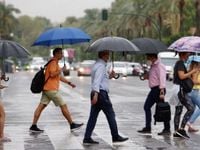As September ushers in a seasonal transition across the Americas, the weather is anything but predictable. In both northern Chile and the Caribbean, meteorological agencies have sounded the alarm over extreme heat and rapidly shifting atmospheric patterns, prompting residents and travelers to brace for a weekend of record-breaking temperatures, health advisories, and, in some regions, the looming threat of heavy rains.
In northern Chile, the Chilean Meteorological Directorate (DMC) has issued a high temperature warning for the regions of Antofagasta and Atacama, effective from the morning of Sunday, September 14, 2025, through the afternoon of Monday, September 15. According to Meteored, the DMC’s warning—designated as code A354/2025—calls attention to an unusual and intense heatwave, with maximum temperatures expected to soar between 33 and 35°C in the Pampa of Antofagasta and up to 34°C in the precordillera of Atacama. These numbers are striking for a month that typically marks the start of meteorological spring, not the height of summer.
The culprit behind this heat surge is a synoptic phenomenon known as a high-pressure ridge, or “dorsal en altura.” As Meteored explains, this atmospheric pattern acts like a giant lid, suppressing cloud formation and promoting what meteorologists call "subsidence": air descends, compresses, and heats up even further. The result? Clear skies, relentless sun, and a significant uptick in thermal readings. “This phenomenon is unusual for September, marking an atypical heat event just before the meteorological start of spring,” Meteored noted.
While the heatwave is confined to northern Chile, its timing is particularly noteworthy. The rest of the country isn’t basking in the same warmth; in fact, central and southern regions are bracing for instability and possible rains. The sharp north-south weather divide is emblematic of the complex atmospheric shifts that often precede Chile’s Fiestas Patrias, a period when outdoor celebrations are common and weather conditions can make or break festivities.
The DMC’s alert is more than a meteorological curiosity; it carries practical implications for daily life. Extreme heat can impact personal health, animal welfare, agriculture, and even electronic equipment. “The warning is important for outdoor activities, travel planning, and personal care due to potential health and environmental impacts,” Meteored emphasized. Residents and visitors are urged to monitor local forecasts closely, adjust their plans accordingly, and take precautions—especially those sensitive to heat.
Meanwhile, on the other side of the continent, a different but equally urgent weather alert is in effect. The National Weather Service (SNM) in San Juan has issued a heat alert for Puerto Rico and the U.S. Virgin Islands for the same weekend—September 13-14, 2025. The warning, as reported by EFE, covers coastal and urban areas, including the islands of Vieques and Culebra, and urges both residents and visitors to stay hydrated and take all necessary precautions against heat-related health risks.
The SNM’s advisory is explicit: the risk of heat stroke is heightened by the combination of high temperatures and elevated humidity. The most intense heat is expected between 10:00 AM and 3:00 PM local time, a window when outdoor exposure could quickly become dangerous. “The warning advises residents and visitors to stay hydrated and take precautions against heat-related health effects,” EFE reported, underlining the seriousness of the situation.
But the Caribbean’s weather story doesn’t end with oppressive heat. Meteorologists have also detected the approach of a tropical wave, expected to begin impacting Puerto Rico and the U.S. Virgin Islands starting Sunday, September 14. This system is forecast to bring a dramatic shift in conditions: an uptick in rainfall, strong showers, thunderstorms, and an increased risk of flooding. The SNM has cautioned that the tropical wave could elevate the threat of flash floods, particularly in low-lying and poorly drained areas.
Local authorities are taking the dual threat seriously. Emergency services have begun monitoring the trajectory of the tropical wave, preparing communities for a weekend featuring two distinct weather fronts: intense heat to start, followed by potentially hazardous rains. “Local authorities are monitoring the situation and advising residents to prepare for two different weather fronts: intense heat followed by heavy rains,” as EFE summarized. The SNM has also called on residents to keep drainage systems clear, secure property, and pay close attention to official updates.
For many in Puerto Rico and the U.S. Virgin Islands, this meteorological one-two punch is a stark reminder of the region’s vulnerability to rapid weather changes. The combination of extreme heat and the threat of tropical downpours poses a unique challenge, especially for those without access to adequate cooling or flood protection. “The information provided by the SNM serves as an essential guide for decision-making and public safety in the region,” EFE remarked, highlighting the critical role of timely communication in disaster preparedness.
Back in Chile, the focus remains squarely on the anomalous heat. The DMC’s alert has not gone unnoticed by those planning outdoor festivities or agricultural activities. A sudden spike in temperature can stress crops and livestock, disrupt work schedules, and even cause power outages if cooling demands surge. The importance of staying informed cannot be overstated: “This type of advisory is key for outdoor activities, travel planning, and personal care,” Meteored reiterated, urging everyone to consult local forecasts and heed official warnings.
While the meteorological phenomena unfolding in Chile and the Caribbean are distinct in their causes and effects, they share a common thread: the growing unpredictability of weather patterns as seasons shift. Whether it’s a high-pressure ridge baking the Atacama under an unseasonably hot September sun or a tropical wave threatening to drench Puerto Rico after a spell of sweltering heat, the message from meteorologists is clear—vigilance and adaptability are essential.
For now, both regions are on high alert, their residents and visitors watching the skies, checking forecasts, and hoping for relief. As spring approaches in the southern hemisphere and summer lingers in the tropics, the only certainty is that the weather will keep everyone guessing.





